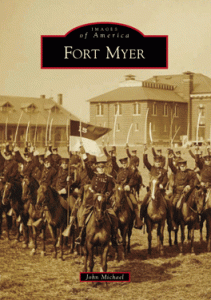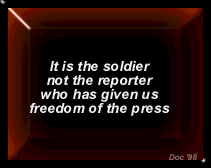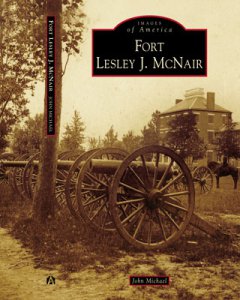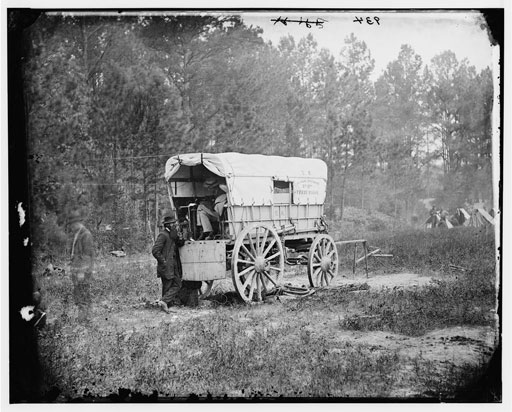Field Office Wagon
A field office wagon was offered by the U.S. Military Telegraph Corps in 1861.
Fields of Honor:
Pivotal Battles of the Civil War
ABOUT THE BOOK:
Few historians have ever captured the drama, excitement, and tragedy of the Civil War with the headlong elan of Edwin Bearss, who has won a huge, devoted following with his extraordinary battlefield tours and eloquent soliloquies about the heroes, scoundrels, and little-known moments of a conflict that still fascinates America. Antietam, Shiloh, Gettysburg: these hallowed battles and more than a dozen more come alive as never before, rich with human interest and colorful detail culled from a lifetime of study. Illustrated with detailed maps and archival images, this 448-page volume presents a unique narrative of the Civil War’s most critical battles, translating Bearss’ inimitable delivery into print. As he guides readers from the first shots at Fort Sumter to Gettysburg’s bloody fields to the dignified surrender at Appomattox, his engagingly plainspoken but expert account demonstrates why he stands beside Shelby Foote, James McPherson, and Ken Burns in the front rank of modern chroniclers of the Civil War, as the Pulitzer Prize-winning McPherson himself points out in his admiring Introduction. A must for every one of America’s countless Civil War buffs, this major work will stand as an important reference and enduring legacy of a great historian for generations to come.
Field Office Wagon
Crucial to the line of communication, a field office wagon gave the battle commander another insight to how things were going at the front
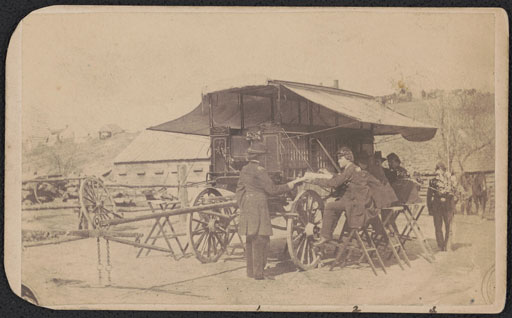
Brigadier General William Dennison Whipple of General Staff U.S. Volunteers Infantry Regiment, Private John Tweedale of Co. B, 15th Pennsylvania Cavalry Regiment, and Private George Q. Allen of Co. B and Co. L, 15th Pennsylvania Cavalry Regiment in uniform working at field office wagon
Field Office Wagon
During a battle, one wagon was stationed at the starting point of the battle to act as a receiving station, while another wagon traveled into the field to be a sending station. Thus, the orders could be sent back and forth between general headquarters and the battlefield, and what occurred during the battles could be sent back to the Military Telegraph Office in Washington, D.C.
The Petersburg Campaign:
The Eastern Front Battles,
June – August 1864,
Volume 1
ABOUT THE BOOK AND THE AUTHORS:
The wide-ranging and largely misunderstood series of operations around Petersburg, Virginia, were the longest and most extensive of the entire Civil War. The fighting that began in early June 1864 when advance elements from the Union Army of the Potomac crossed the James River and botched a series of attacks against a thinly defended city would not end for nine long months. This important—many would say decisive—fighting is presented by legendary Civil War author Edwin C. Bearss in The Petersburg Campaign: The Eastern Front Battles, June–August 1864, the first in a ground-breaking two-volume compendium.
Although commonly referred to as the “Siege of Petersburg,” that city (as well as the Confederate capital at Richmond) was never fully isolated and the combat involved much more than static trench warfare. In fact, much of the wide-ranging fighting involved large-scale Union offensives designed to cut important roads and the five rail lines feeding Petersburg and Richmond. This volume of Bearss’ study of these major battles includes:
The Attack on Petersburg (June 9, 1864)
The Second Assault on Petersburg (June 15 – 18, 1864)
The Battle of the Jerusalem Plank Road (June 21 – 24, 1864)
The Crater (July 30, 1864)
The Battle of the Weldon Railroad (August 18 – 21, 1864)
The Second Battle of Ream’s Station (August 25, 1864)Accompanying these salient chapters are original maps by Civil War cartographer George Skoch, together with photos and illustrations. The result is a richer and deeper understanding of the major military episodes comprising the Petersburg Campaign.
About the Authors: Edwin C. Bearss is a world-renowned military historian, author, and tour guide known for his work on the American Civil War and World War II. Ed, a former WWII Marine wounded in the Pacific Theater, served as Chief Historian of the National Park Service from 1981 to 1994 and is the author of dozens of books and articles. He discovered and helped raise the Union warship USS Cairo, which is on display at Vicksburg National Military Park.
Bryce A. Suderow is a Civil War writer and researcher living in Washington, D.C. He received his B.A. at Knox College and earned a Masters in American History at Sonoma State University. His Masters’ Thesis, Thunder in Arcadia Valley, was published in 1985 (Univ. of Missouri). Bryce has also published many articles in a number of Civil War periodicals and is recognized as one of the finest archival researchers working today.
Siege of Petersburg
Within the city, there is the Siege Museum which documents civilian life in Petersburg from June of 1864 through April of 1865, a time during which Petersburg residents were subjected to the longest military siege on United States soil.
Visiting the Siege Museum
During your visit to this Petersburg, Virginia attraction, watch “Echoes Still Remain” to learn about the city’s involvement in the Civil War. In the Museum’s permanent exhibition discover what day-to-day life would have been like for the residents during the 10-month Siege of Petersburg. On display is a field office wagon among other artifacts that highlight the “long-drawn-out battle”.
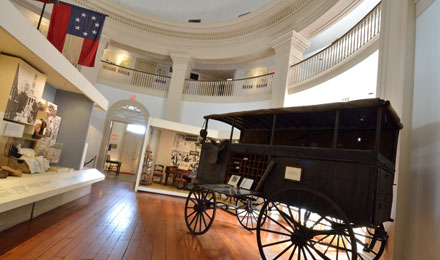
Courtesy of the Siege Museum -Field Office Wagon
The Petersburg Campaign:
The Eastern Front Battles,
June – August 1864,
Volume 2
ABOUT THE BOOK AND THE AUTHORS:
Winner, 2014, The Douglas Southall Freeman Award
The wide-ranging and largely ignored operations around Petersburg, Virginia, were the longest and most extensive of the entire Civil War. The fighting began in June of 1864, when advance elements from the Union Army of the Potomac crossed the James River and botched a series of attacks against a thinly defended city. The fighting ended nine long months later in the first days of April of 1865. In Volume, I of The Petersburg Campaign, legendary historian Edwin C. Bearss detailed the first six major engagements on the “Eastern Front,” from the initial attack on the city on June 9 through the Second Battle of Ream’s Station on August 25, 1864. In Volume II, Bearss turns his attention and pen to the final half-dozen large-scale combats in The Petersburg Campaign: The Western Front Battles, September 1864 – April 1865.Although commonly referred to as the “Siege of Petersburg,” the city (as well as the Confederate capital at Richmond) was never fully isolated and the combat involved much more than static trench warfare. In fact, much of the wide-ranging fighting involved massive multi-corps Union offensives designed to cut important roads and rail lines feeding Petersburg and Richmond. This second installment includes these major battles:
– Peebles’ Farm (September 29 – October 1, 1864)
– Burgess Mill (October 27, 1864)
– Hatcher’s Run (February 5 – 7, 1865)
– Fort Stedman (March 25, 1865)
– Five Forks Campaign (March 29 – April 1, 1865)
– The Sixth Corps Breaks Lee’s Petersburg Lines (April 2, 1865)Accompanying these salient chapters are two dozen original maps by Civil War cartographer George Skoch, coupled with photos and illustrations. Taken together, these two volumes present the most comprehensive and thorough understanding of the major military episodes comprising the fascinating ‘Petersburg Campaign’.
About the Authors: Edwin C. Bearss is a world-renowned military historian, author, and tour guide known for his work on the American Civil War and World War II. Ed, a former WWII Marine wounded in the Pacific Theater, served as Chief Historian of the National Park Service from 1981 to 1994 and is the author of dozens of books and articles. He discovered and helped raise the Union warship USS Cairo, which is on display at Vicksburg National Military Park.
Bryce A. Suderow is a Civil War writer and researcher living in Washington, D.C. He received his B.A. at Knox College and earned a Masters in American History at Sonoma State University. His Masters’ Thesis, Thunder in Arcadia Valley, was published in 1985 (Univ. of Missouri). Bryce has also published many articles in a number of Civil War periodicals and is recognized as one of the finest archival researchers working today.
Field Office Wagon
Petersburg, Va. U.S. Military Telegraph battery wagon, Army of the Potomac headquarters
Learn About John Michael and his dedicated mission

